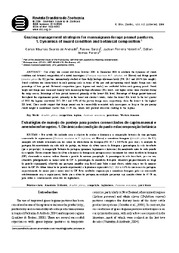Grazing management strategies for massaigrass-forage peanut pastures. 1. Dynamics of sward conditions and botanical composition.
Grazing management strategies for massaigrass-forage peanut pastures. 1. Dynamics of sward conditions and botanical composition.
Autoria: ANDRADE, C. M. S. de; GARCIA, R.; VALENTIM, J. F.; PEREIRA, O. G.
Resumo: This study was carried out from October 2002 to December 2003 to evaluate the dynamics of sward condition and botanical composition of a mixed massaigrass (Panicum maximum x P. infestum, cv. Massai) and forage peanut (Arachis pintoi Ac 01) pasture, intermittently stocked at three daily herbage allowance levels (9.0, 14.5 and 18.4% live weight). Sward condition was characterized in each grazing cycle in terms of the pre- and post-grazing sward height, forage mass and percentage of bare ground. Botanical composition (grass, legume and weeds) was evaluated before each grazing period. Sward height and forage mass increased linearly with increasing herbage allowance (HA) levels, and higher values were observed during the rainy season. Percentage of bare ground increased primarily at the lowest HA level. Percentage of forage peanut increased throughout the experimental period, primarily in the barest and shortest swards, under the lowest HA level. In the last quarter of 2003 the legume constituted 23.5, 10.6 and 6.4% of the pasture forage mass, respectively, from the lowest to the highest HA level. These results suggest that forage peanut can be successfully associated with massaigrass, as long as the pre-grazing sward height is maintained shorter than 65-70 cm, which will prevent excessive shading to the legume.
Ano de publicação: 2006
Tipo de publicação: Artigo de periódico
Unidade: Embrapa Acre
Palavras-chave: Amazonia occidental, Amazônia Ocidental, Amendoim forrageiro, Arachis pintoi, Botanical composition, Capim massai, Competición vegetal, Composición botánica, Composição botânica, Forage legumes, Forage peanut, Hybrids, Híbrido, Híbridos, Leguminosa forrageira, Leguminosas forrajeras, Mixed grazing, Mixed massaigrass, Panicum maximum x P infestum cv Massai, Pastagem consorciada, Pastejo rotativo, Pastoreo de rotación, Pastoreo mixto, Plant competition, Rotational grazing, Western amazon
Observações
1 - Por padrão são exibidas publicações dos últimos 20 anos. Para encontrar publicações mais antigas, configure o filtro ano de publicação, colocando o ano a partir do qual você deseja encontrar publicações. O filtro está na coluna da esquerda na busca acima.
2 - Para ler algumas publicações da Embrapa (apenas as que estão em formato ePub), é necessário ter, no celular ou computador, um desses softwares gratuitos. Sistemas Android: Google Play Livros; IOS: iBooks; Windows e Linux: software Calibre.
Acesse outras publicações
Acesse a Base de Dados da Pesquisa Agropecuária (BDPA) para consultar o acervo completo das bibliotecas da Embrapa.

